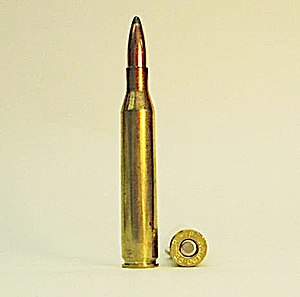.25-06 Remington
| .25-06 Remington | ||||||||||||||||
|---|---|---|---|---|---|---|---|---|---|---|---|---|---|---|---|---|

.25-06 Remington cartridge
|
||||||||||||||||
| Type | Rifle, Hunting | |||||||||||||||
| Production history | ||||||||||||||||
| Designer | Remington Arms Company | |||||||||||||||
| Designed | 1969 | |||||||||||||||
| Manufacturer | Remington | |||||||||||||||
| Produced | 1969-Present | |||||||||||||||
| Specifications | ||||||||||||||||
| Parent case | .30-06 | |||||||||||||||
| Bullet diameter | .257 in (6.5 mm) | |||||||||||||||
| Neck diameter | .290 in (7.4 mm) | |||||||||||||||
| Shoulder diameter | .441 in (11.2 mm) | |||||||||||||||
| Base diameter | .470 in (11.9 mm) | |||||||||||||||
| Rim diameter | .473 in (12.0 mm) | |||||||||||||||
| Rim thickness | .05 in (1.3 mm) | |||||||||||||||
| Case length | 2.494 in (63.3 mm) | |||||||||||||||
| Overall length | 3.250 in (82.6 mm) | |||||||||||||||
| Case capacity | 65.8 gr H2O (4.26 cm3) | |||||||||||||||
| Rifling twist | 1 in 10 in (250 mm) | |||||||||||||||
| Primer type | Large rifle | |||||||||||||||
| Maximum pressure | 63,000 psi (430 MPa) | |||||||||||||||
| Ballistic performance | ||||||||||||||||
|
||||||||||||||||
|
Test barrel length: 24" Source(s): Remington Arms |
||||||||||||||||
The .25-06 Remington had been a wildcat cartridge for half a century before being standardized by Remington in 1969. It is based on the .30-06 Springfield cartridge necked-down (case opening made narrower) to .257 caliber with no other changes. Nominal bullet diameter is 0.257 inches (6.53 mm) and bullet weights range from 75 to 120 grains (4.9 to 7.8 g).
Charles Newton necked down the .30-06 Springfield cartridge in 1912 to accept the 117-grain .25-35 Winchester bullet. Newton's early modification encouraged commercial release of a shortened case (from 63 to 49mm) as the .250-3000 Savage in 1915.Frankford Arsenal developed an experimental .25-06 during World War I; and distribution of surplus United States military equipment through the Civilian Marksmanship Program following the war encouraged independent gunsmiths to experiment with the cartridge.A. O. Niedner of Dowagiac, Michigan introduced rifles for the .25 Niedner in 1920. Niedner Arms Corporation retained the 17° 30′ .30-06 shoulder chambering .25 caliber barrels rifled with one twist in 12 inches (300 mm). Similar cartridges were identified as the .25 Hi-Power, .25 Whelen (analogous to .35 Whelen), or .25-100-3000 (to indicate the ability to achieve 3000 feet per second with a 100 grain bullet rather than the 87 grain bullet used in the .250-3000 Savage). Greater case capacity offered minimal velocity improvement over the .250-3000 Savage case with contemporary smokeless powders. Availability of DuPont's Improved Military Rifle (IMR) powders encouraged commercial release of the .257 Roberts using the 57mm-long Mauser case in 1934. Release of IMR 4350 in 1940 and availability of surplus 4831 powder salvaged from Oerlikon 20mm cannon cartridges after World War II greatly improved performance of the full-length .25-06 case.
...
Wikipedia
